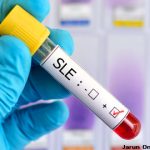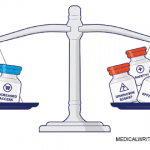For some patients with systemic lupus erythematosus, regular repeated treatment with rituximab may prevent disease flare, according to a study from Cassia et al.


For some patients with systemic lupus erythematosus, regular repeated treatment with rituximab may prevent disease flare, according to a study from Cassia et al.

RA patients experience a higher rate of cardiovascular disease (CVD) events than controls. In a new study, Karpouzas et al. determined that current biologic disease-modifying anti-rheumatic drug use is associated with reduced long-term CVD risk, protective calcification of noncalcified lesions and a lower likelihood of new plaque formation in patients with early atherosclerosis.
In a new study, Spiera et al. assessed the safety and efficacy of lenabasum, a synthetic, orally administered agonist of cannabinoid receptor 2 that modulates the endocannabinoid system to activate the resolution phase of innate immune responses, in diffuse cutaneous systemic sclerosis…
In a new study, Baker et al. examined reference product and biosimilar orders, comparing data from a Veterans Affairs Medical Center (VAMC) to those from an academic medical center…

Bryn Nelson, PhD |
As useful stand-ins for biologics targeting a range of inflammatory diseases, biosimilars have made significant inroads across Europe as less expensive alternatives. Denmark, for example, realized a cost savings of 64% after instituting a mandatory national switch from the originator infliximab to its biosimilar counterpart. In the U.S., however, a considerably smaller fraction of rheumatologists…
According to a new study, the prevalence of anti-nuclear antibodies (ANAs), the most common biomarker of autoimmunity in the U.S., has increased considerably in recent years among adolescents aged 12–19 years, in both sexes (especially in men), older adults (age ≥50 years) and non-Hispanic whites…

In a matter of weeks, the COVID‑19 crisis has totally upended clinical medicine and the practice of rheumatology. Our old ways of seeing patients in person, precepting fellows in clinic or on the consult service, and leading in-person interactive teaching rounds are gone for now and possibly for good. But how can we replace these…
Miller-Archie et al. set out to determine whether dust exposure and PTSD are associated with an increased risk of systemic autoimmune disease in a 9/11-exposed cohort not included in previous studies of members of the Fire Department of New York and whether this association differs between 9/11 responders and community members.
Marilynn Larkin |
NEW YORK (Reuters Health)—The prevalence of antinuclear antibodies (ANA) in the blood of U.S. adolescents and adults has increased over the past 30 years, signaling a rise in autoimmunity, researchers say. “It is not known if these same increases are occurring in other parts of the world, but because ANA are associated with many autoimmune…
Interstitial lung disease accompanied by anti-melanoma differentiation-associated gene 5 positive dermatomyositis is often rapidly progressive and associated with poor prognosis. In this study, a combined immunosuppressive regimen of high-dose glucocorticoids, tacrolimus and intravenous cyclophosphamide proved more effective than treatment with high-dose glucocorticoids and stepwise addition of an immunosuppressant in a historical control group.